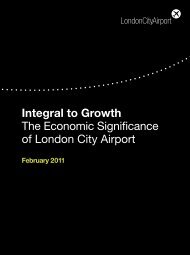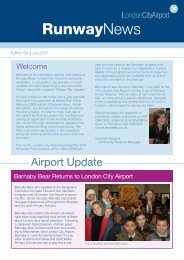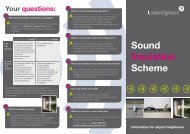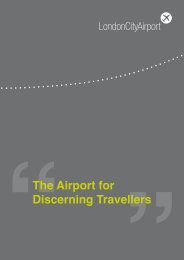Sustainability Stratergy and Action Plan - London City Airport
Sustainability Stratergy and Action Plan - London City Airport
Sustainability Stratergy and Action Plan - London City Airport
You also want an ePaper? Increase the reach of your titles
YUMPU automatically turns print PDFs into web optimized ePapers that Google loves.
22<br />
<strong>London</strong> <strong>City</strong> <strong>Airport</strong><br />
<strong>Sustainability</strong> Strategy <strong>and</strong> <strong>Airport</strong> <strong>Sustainability</strong> <strong>Action</strong> <strong>Plan</strong><br />
2012 - 2014<br />
A summary of the objectives <strong>and</strong> commitments in the<br />
Biodiversity Strategy is given below:<br />
• LCY will participate as a “Delivery Partner” in the<br />
Newham Biodiversity Partnership (NBP).<br />
• LCY will promote awareness-raising activities on<br />
the benefits of wildlife habitats, including making<br />
an offer to support the delivery of outdoor events in<br />
conjunction with local centres.<br />
• In partnership with an expert organisation such as<br />
the Field Studies Council, to fund to the total value<br />
of up to £2000, the development <strong>and</strong> delivery of<br />
specific biodiversity projects in schools within the<br />
57dB noise contour for that year.<br />
• LCY will advertise opportunities <strong>and</strong> consider<br />
sponsorship requests from local schools <strong>and</strong><br />
community-led organisations for the establishment<br />
of small educational wildlife gardens (or similar) at<br />
appropriate locations in the airport’s catchment.<br />
• LCY will also inform LCY staff of the importance of<br />
biodiversity as part of a “sustainability awareness”<br />
briefing in their initial induction.<br />
• LCY will fund <strong>and</strong> assist the organisation of the<br />
placement of, interpretation boards at local Sites<br />
of Interest for Nature Conservation (SINC) within<br />
the Borough, including North side of the Royal<br />
Albert Dock (adjacent to Building 1000), Newham<br />
<strong>City</strong> Farm SINC, King George V Park <strong>and</strong> Beckton<br />
District Park.<br />
In addition to these commitments, we will explore<br />
opportunities for localised enhancements to the<br />
biodiversity of the airport site, where practical. For<br />
example, we propose to undertake a feasibility<br />
study on the costs <strong>and</strong> benefits of installing<br />
sedum mats (or alternative substrate) on the roof<br />
of <strong>City</strong> Aviation House or another suitable building<br />
at the airport, with the objective of providing a<br />
micro-habitat for BAP priority species such as<br />
invertebrates. We will also undertake an aquatic<br />
ecological survey of the King George V Dock, in<br />
conjunction with RoDMA, to determine whether<br />
any enhancements can be made to the biochemical<br />
quality <strong>and</strong> ecology of this water body.<br />
Performance against the <strong>Airport</strong> Biodiversity<br />
Strategy will be reported in the APR.<br />
Noise<br />
2.6 Noise associated with LCY is managed under<br />
the terms of the planning agreement between the<br />
airport <strong>and</strong> the <strong>London</strong> Borough of Newham (LBN).<br />
The airport is bound by various requirements to<br />
monitor, mitigate <strong>and</strong> compensate for adverse<br />
effects of aircraft noise. As part of this obligation,<br />
we have implemented a number of specific<br />
initiatives which allow us to continue to manage<br />
noise carefully.<br />
During the 2010 calendar year, LCY continued to<br />
operate its existing Noise Management Scheme<br />
(NMS), which amongst other things provides a<br />
system of incentives <strong>and</strong> penalties in order to<br />
minimise noise disturbance from aircraft using the<br />
airport. The NMS also controls the maximum noise<br />
levels of the type of aircraft authorised to use the<br />
airport. Furthermore, there are a number of long<br />
st<strong>and</strong>ing characteristics of the operation of the<br />
airport which help reduce its noise impact:<br />
• The airport is closed at night <strong>and</strong> for 24 hours at the<br />
weekend;<br />
• Because of specific obstacle clearance<br />
requirements, aircraft l<strong>and</strong>ing <strong>and</strong> departing at<br />
<strong>London</strong> <strong>City</strong> <strong>Airport</strong> are required to approach at a<br />
steeper angle than other airports. This reduces the<br />
area affected by noise; <strong>and</strong><br />
• There is a sound insulation scheme where homes<br />
<strong>and</strong> public buildings may qualify for sound<br />
insulation, set at thresholds which represent some<br />
of the lowest noise levels of any UK airport.<br />
The airport has prepared a Noise Monitoring <strong>and</strong><br />
Mitigation Strategy (NOMMS) as part of the 2009<br />
Section 106 Agreement. This Strategy builds on<br />
the existing Noise Management Scheme, but also<br />
introduces new initiatives, including:<br />
• The measurement <strong>and</strong> monitoring of ground noise;<br />
• Formalising measures for limiting the use of<br />
Auxiliary Power Units (APUs) before departure <strong>and</strong><br />
after l<strong>and</strong>ing;<br />
• Encouraging, consistent with safe operations, the<br />
minimum use of reverse thrust on l<strong>and</strong>ing.










